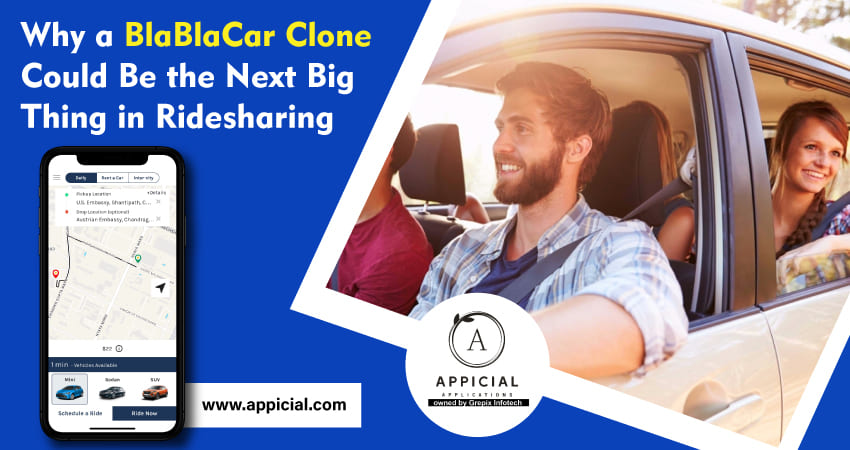
Why a BlaBlaCar Clone Could Be the Next Big Thing in Ridesharing
In the rapidly evolving world of urban mobility, ridesharing has become a cornerstone of how we think about travel. Platforms like Uber and Lyft have paved the way, but as we move forward, niche markets and specialized services are beginning to take center stage. One such niche that’s gaining traction is long-distance ridesharing, exemplified by BlaBlaCar. For entrepreneurs and businesses looking to enter this space, developing a BlaBlaCar clone could be more than just a viable venture—it could be a revolutionary step.
The blog explores the potential of a BlaBlaCar clone in transforming the ridesharing industry by focusing on long-distance carpooling. It highlights the economic, environmental, and social benefits of such a model, which offers cost-effective travel, reduces carbon emissions, and enhances social connectivity. The clone could fill significant market gaps, especially in underserved routes, and is scalable across different regions. Key features for success include robust user profiles, flexible payment options, and real-time communication tools. Success stories from similar platforms demonstrate the viability of this model. Overall, a BlaBlaCar clone represents a promising opportunity in the evolving transportation landscape.
Understanding the Appeal of BlaBlaCar
BlaBlaCar has carved out a unique position in the ridesharing landscape by facilitating affordable long-distance travel. Unlike traditional ridesharing services that focus on short urban routes, BlaBlaCar connects drivers and passengers who wish to share long-distance travel costs, making inter-city commuting affordable and social.The model benefits all parties involved:
- Economic Efficiency for Drivers: Drivers can offset a significant portion of their travel expenses by filling otherwise empty seats, making their trips more economical.
- Affordable Transportation for Passengers: Passengers benefit from a more affordable travel option compared to other modes of transport such as trains or buses, particularly for long-distance routes.
- Environmental Sustainability: The model contributes positively to the environment by lowering the per capita carbon emissions. Fewer cars on the road mean reduced traffic congestion and pollution.
- Social Interaction: The service also adds a social element to travel, allowing people to connect with others and make new acquaintances, enriching the travel experience.
Understanding the Appeal of BlaBlaCar
- Drivers get to offset their travel costs by sharing empty seats.
- Passengers access a cost-effective mode of transportation.
- Environment benefits from reduced carbon emissions per capita.
Market Potential for a BlaBlaCar Clone
Ridesharing for long distances is not just a niche market—it's a growing trend. As travel costs rise and environmental awareness increases, more consumers are looking for economical and eco-friendly ways to travel. A BlaBlaCar clone can tap into this growing demand by providing a platform that offers reliability, safety, and community trust, elements that are crucial for long-distance travel sharing.
- Cost-Effective Travel Demand: As economic pressures mount globally, more consumers are seeking ways to cut travel costs. A BlaBlaCar clone, focusing on sharing the expenses of long-distance trips, meets this demand effectively, offering an affordable alternative to traditional transportation modes like trains and private cars.
- Environmental Concerns: With increasing awareness of environmental issues, there is a rising trend towards more sustainable travel choices. A service that reduces the number of vehicles on the road and minimizes carbon emissions per trip would appeal to eco-conscious consumers.
- Social Connectivity: In a world where social isolation has become more prevalent due to various global events, a platform that encourages social interaction through shared travel experiences could resonate well. It provides an opportunity to meet new people and build connections, adding a unique value proposition.
- Under-Served Routes: Many regions and routes are not adequately served by public transport or existing ridesharing services. A BlaBlaCar clone could capitalize on this gap by facilitating travel in rural or less accessible areas, thus broadening its user base.
- Technology Integration: Advances in mobile technology and app functionalities, such as real-time tracking, secure payment systems, and user verification, enhance the appeal and usability of such a platform, ensuring a smooth and safe user experience.
- Scalability: The model is inherently scalable, capable of expanding to new markets and regions with relative ease, provided local transportation regulations and market conditions are favorable.
- Regulatory Landscape: Understanding and navigating the regulatory environments in different regions will be crucial. In some areas, the shared economy is encouraged, while in others, it faces significant hurdles.
- Competitive Landscape: While BlaBlaCar is a leader in long-distance carpooling, a new entrant would need to offer distinct innovations or better service elements to attract users from established competitors.
Also Read: Best Ride-Hailing and Taxi Apps in Russia
Key Features of a Successful BlaBlaCar Clone
To ensure the success of a BlaBlaCar clone, certain key features must be integrated:
- Robust User Profiles: Comprehensive profiles that include verified information about drivers and passengers enhance trust and safety.
- Rating and Review System: Helps maintain a high-quality community and allows users to make informed decisions.
- Flexible Payment Solutions: Secure and versatile payment options are essential for user convenience.
- Intelligent Route Matching: Advanced algorithms to match passengers with the best possible routes to maximize car occupancy and minimize detours.
- Real-time Communication Tools: Seamless communication within the app improves user experience and coordination.
- Privacy and Security Protocols: Strong data protection measures to safeguard personal information.
Technological Requirements
Developing a BlaBlaCar clone involves intricate technology stack decisions:
- Frontend Development: Technologies like React or Angular for a responsive, intuitive user interface.
- Backend Development: Robust frameworks such as Node.js or Ruby on Rails to handle operations seamlessly.
- Database Management: SQL or NoSQL databases to manage user data, trip details, and more efficiently.
- APIs for Location Services: Integration of APIs for geolocation features to facilitate route planning and matching.
- Mobile Compatibility: Android and iOS applications to reach a broader audience.
Legal and Regulatory Considerations
Before launching a BlaBlaCar clone, it's crucial to understand the legal landscape:
- Rideshare Licensing: Depending on the region, specific licenses may be required to operate a ridesharing service.
- Insurance: Adequate insurance covering both drivers and passengers during shared trips is mandatory.
- Data Protection Laws: Compliance with GDPR in Europe or similar regulations in other jurisdictions to protect user data.
Marketing Strategies for Promoting Your Clone
A strategic marketing campaign is vital to penetrate the market effectively:
- Targeted Advertising: Utilize digital advertising platforms to target potential users based on their travel habits and preferences.
- Partnerships: Collaborate with travel and tourism agencies to broaden your service’s reach.
- Social Media Engagement: Active engagement on social media to build a community around your brand.
Success Stories: Inspiration from Existing Clones
Many successful BlaBlaCar clones have demonstrated the model's viability, such as CarpoolWorld or Rideshare. These platforms have grown significantly by focusing on community-building and robust platform functionality, proving the business model's potential.
- Grab (Southeast Asia): Originally launched as MyTeksi in Malaysia, Grab expanded rapidly across Southeast Asia by adapting the Uber model to local conditions, including the integration of motorbikes and tuk-tuks alongside cars. Grab's success lies in its deep understanding of local travel habits, regulatory environments, and payment preferences, which helped it outpace Uber in the region.
- Ola (India): Ola has successfully replicated the ride-hailing service model in India, providing services that cater specifically to Indian consumers, such as a wide range of vehicle options from economical rickshaws to luxury cars, and features tailored to local preferences like Ola Play (in-car entertainment system).
- Didi Chuxing (China): Didi started as a simple taxi-hailing app and evolved into a full-scale transport solution, offering a variety of commuting services, including a carpooling option similar to BlaBlaCar. Didi’s deep integration with Chinese infrastructure and its strategic partnerships with local municipalities have been crucial to its dominance.
- Lyft (USA): Although not a clone, Lyft’s strategic decision to focus on a friendly, community-oriented brand image as a point of differentiation from Uber shows the importance of brand positioning. Lyft also expanded into bike-sharing and scooter services, demonstrating the potential of diversifying services under one platform.
- Bolt (Europe and Africa): Bolt, formerly known as Taxify, has capitalized on markets that Uber was slow to enter. It offers competitive rates and lower commission rates for drivers, which helped it gain a strong foothold in both European and African markets.
- Gojek (Indonesia): Initially a motorcycle ride-booking service, Gojek has become a one-stop app for a variety of services in Indonesia and other Southeast Asian countries. Its success stems from its super-app model that includes food delivery, shopping, and even financial services, tailored to the needs and habits of its users.
Conclusion
In conclusion, a BlaBlaCar clone represents a promising frontier in the ride-sharing industry, particularly as global travel habits evolve towards more sustainable and cost-effective options. By focusing on long-distance carpooling, such a platform can fill a vital niche, offering economic benefits to drivers and passengers alike while reducing environmental impact. The success of similar models across various markets—illustrated by companies like Grab, Ola, and Didi—underscores the potential for a BlaBlaCar clone to not only thrive but also innovate within this space.
For taxi app developers, this represents a golden opportunity to diversify offerings and tap into a growing segment of consumers looking for affordable, reliable, and eco-friendly transportation options. With the right approach—leveraging local insights, integrating advanced technological features, and ensuring a user-friendly experience—a BlaBlaCar clone could indeed be the next big thing in ride-sharing. As the industry moves forward, embracing these new models will be key to staying competitive and meeting the dynamic needs of today’s mobile-first, environmentally conscious consumers. Embracing this opportunity could set the stage for significant growth, sustainability, and continued innovation in the ride-sharing ecosystem.








